|
TRANSLATE THIS ARTICLE
Integral World: Exploring Theories of Everything
An independent forum for a critical discussion of the integral philosophy of Ken Wilber
 Egil Asprem Egil Asprem is a Norwegian scholar of esotericism, religion, and intellectual history, with a penchant for philosophy (mostly analytic). He is currently a postdoctoral scholar in the Department of Religious Studies at University of California Santa Barbara and the author of Arguing with Angels (SUNY Press, 2012), Contemporary Esotericism (Equinox / Acumen, 2013) and the award winning dissertation The Problem of Disenchantment ( PhD thesis, University of Amsterdam, 2013). Check out his blog.
December 29, 2012,
January 6,
January 21, and
March 3, 2013, with permission of the author.
Scientific delusions,
or delusions
about science?
Review of Rupert Sheldrake's
The Science Delusion
Egil Asprem
1. Rupert Sheldrake's Ten Dogmas
The overall argument of The Science Delusion rests on a number of stereotypes about modern science and its history.
Rupert Sheldrake’s latest book, The Science Delusion (2012; Science Set Free in the US), has been given quite a lot of attention this year. Through its UK title, the book is clearly situated in the market as a sort of counter-manifesto to Dawkins’ God Delusion, or more precisely to the so-called “New Atheism’s” attempt to monopolize discourses on science for a wholly secular, atheistic, and anti-”magical” worldview. Sheldrake’s book has indeed worked as a sort of battle cry for a certain segment of the educated population left cold by creationists and new atheists alike, in fact a rather big group that wants to retain a worldview hospitable to irreducible mysteries without compromising their identity as modern, scientific-minded, rational people.
Sometimes, this rather precarious situation—of wanting science to be something else than what the scientists appear to make it—triggers a form of “ressentiment” against what is perceived as a dominating elite: “Materialist” elite scientists are exercising a “corrupting” influence across the fields of science. Had they not, everyone would have seen it our way. This sort of ressentiment is evident in much of Sheldrake’s polemic. There is much talk of “Science” as a gargantuan single entity, and what “it” dogmatically says and does. Perhaps that is what one would expect from someone who ditched a mainstream scientific career decades ago to pursue the elusive promises of parapsychology, while tirelessly expanding and pushing his own neo-vitalistic theories of “morphic resonance” and the “morphogenetic field” (rejected by his peers) in books and articles published for a wider and much more enthusiastic audience. His popular image as a persecuted visionary was greatly enhanced by the senior editor of Nature John Maddox, who foolishly entitled his review of Sheldrake’s A New Science of Life (1981) “a book for burning?”. Commercially speaking, it was probably the best review Sheldrake could ever have hoped for.
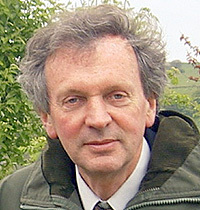 Rupert Sheldrake - hero, heretic, or
Rupert Sheldrake - hero, heretic, or
just another populist science writer?
Despite a carefully kept image of being victimized by intolerant oppressors, Sheldrake’s message and rhetoric (the two are closely intertwined and codependent) falls in fertile ground among those who shape public opinion. One only has to look at the number of book reviewers and journalists writing enthusiastically about The Science Delusion in mainstream media. Mary Midgley endorsed the book wholesale in her review for The Guardian last February. Colin Tudge, writing for The Independent, even praised Sheldrake for doing us all a great favour by exposing the “dogmas” of modern science. A portrait interview in The Guardian was more sober (they had the decency to put “heretic” in scare-quotes), but gave Sheldrake all the time and space he wanted to elaborate on his viewpoints and communicate his allegedly persecuted ideas to the masses.
After the renegade biochemist gave a public lecture in my native Norway last month, his science-criticism also reached the Norwegian media. It was reproduced several times over in the press, although mostly in much less compelling and sophisticated ways than the original. In general, major media outlets are happy to lend a microphone or a keyboard to Sheldrake’s central accusation that science has deluded itself. Or as he put it in a Huffington Post spin-off: that "[t]he sciences are being held back by assumptions that have hardened into dogmas, maintained by powerful taboos”.
The reader should have guessed by now that I am not all that impressed. It is not that I disagree with the most basic message that Sheldrake tries to convey: that science should be based on “radical scepticism”, not tolerate dogmas, and always search for new questions instead of final answers. The problem is that he comes bursting through doors that are already wide open. I cannot avoid thinking that the accusation of scientific dogmatism is itself inherently dogmatic. It reads a bit too much like a predictable response to those who, having applied the sceptical attitude Sheldrake claims to cherish to his own pet theories, have walked away unconvinced.
So let us turn Sheldrake’s imperative back at his book, turning some of the rigidly stated assumptions and certainties in it into questions instead. Rather than accepting the statement that “science is deluded” on face value, let us ask, “is science really deluded?” And let us approach the “ten dogmas” that Sheldrake lists and uses to structure the chapters of his book with some scepticism. Are these really “dogmas” at all, or is there something else going on? Are they really delusions of science, or is it perhaps the list itself that presents a deluded picture of what “science” is all about?
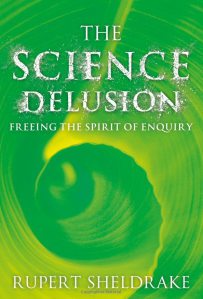
When we do this, it quickly appears that the overall argument of the Science Delusion rests on a number of stereotypes about modern science and its history. The ways the book handles central philosophical issues in the domains of epistemology (otherwise the philosophy of science) and the philosophy of mind are woefully superficial. But there is also another and more puzzling thing at work: while Sheldrake’s supporters seem to think that he is an impressively original thinker, the stereotypes that he reproduces are in fact far from new. A rudimentary grasp of the history of modern science and philosophy should be enough to recognize them as echoes of the science-scepticism of earlier ages—from the post-Enlightenment romantics, through the psychical researchers of the late-19th century, to the anti-scientific intellectuals-in-denial that blossomed in continental Europe and elsewhere after the First World War. Sheldrake’s own generation of science-critics, formed in the context of the cold war, against the expansion of “big science” and “big pharma”, under the influence of the student rebellions and the psychedelic era, and closely aligned with an increasingly mass-popularised and commodified “counter-culture”, brings little that is substantially new to these earlier periods.
The best way to demonstrate these claims is by a point by point walk-through of Sheldrake’s “ten dogmas”. Doing that after such a lengthy general introduction would however be much too taxing, so this will follow in separate installments.
To give you a grasp of what you have in store, here is Sheldrake’s list in abridged form:
According to Sheldrake, the ten dogmas of science hold that:
- Everything is mechanical; only mechanistic explanations will do.
- Matter is unconscious / inanimate.
- The matter and energy of the universe is constant, and has remained constant since the Big Bang.
- The laws of nature are fixed.
- Nature is without inherent purpose, and evolution has no goal.
- Biological inheritance is a purely material process.
- Minds are located within heads, and are nothing but the activities of brains.
- Memories are stored in the brain, and are wiped out at death.
- Telepathy and other psychic phenomena are illusory.
- Mechanistic medicine is the only kind that works.
If these strike you as true, provocative, or completely misguided, now is the time to think through why that is. I have spent quote some time thinking about and researching the way in which problems of this type have historically been handled by scientists, philosophers and other thinkers, as part of my recently completed dissertation. I see them as elements of what I call “the problem of disenchantment”, and Sheldrake fits right in as a spokesperson for a specific kind of response to that problem. More on this in the next installment, where I will start by discussing the claim of the first dogma: What does it mean to say that science is mechanistic?
In the unlikely case that you are exceptionally eager to know what I might have to say about this, why not check out some previous posts on disenchantment, psychical research, or the relation between science and religion?
2. Mechanism, life, and consciousness
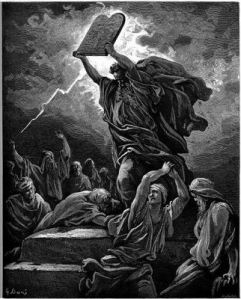 Do you know the meaning of dogmatic?
Do you know the meaning of dogmatic?
In the previous post on Rupert Sheldrake’s Science Delusion, I noted that the overall argument is based on a number of misrepresentations and stereotypes of what “science” is up to. The reader gets the impression of a monolithic structure, big-S-”Science”, now dominated by Ten Dogmas, like commandments cut in stone tablets. The history of science has, of course, been rather more complicated. Several of the dogmas do not even correspond well with the actual theories that are pursued today: at best they represent a pointed caricature, at worst, they build on stereotypes crafted about a century or longer ago, that hardly have any relevance for contemporary scientific practice. Even to the extent that some of the “dogmas” refer to presently widespread theoretical or methodological conventions, holding these to be fixed dogmas obscures the fact that they are the outcome of long and sometimes complicated historical developments, both internal and external to science. In short: that x is a widely held belief does not make x a “dogma”; that y is a commonly recommended way of pursuing a task does not make y a dogmatic procedure.
As promised in the previous post, I will go through the ten dogmas one by one to demonstrate some of these points. In the present one we shall focus on the first two, which have to do with questions about mechanism, vitalism, scientific method, materialism, and the problems of defining “consciousness”. We will visit some historical backgrounds and parallels to Sheldrake’s criticism of science, and test his claim that science has closed certain questions “dogmatically”, by holding them up against the actual historical developments of some of the special sciences. Without further ado, here goes dogma #1:
1. “Everything is mechanical”.
The first scientific commandment appropriately holds that “Thou shalt have no other theoretical framework than the mechanical”. According to Sheldrake, “modern science” = “mechanical theories”. That science “reduces everything to mechanical processes”, essentially to “matter in motion”, is one of the older and most fundamental accusations on the list. It can be traced all the way back to the birth and spread of the so-called mechanical philosophy of nature itself in the early modern period. According to the charges,”the mechanistic dogma” holds that all phenomena are straight-jacketed into “mechanistic” and “materialist” frameworks.
Complaints about this are often made with reference to the phenomena of life and minds. As Sheldrake writes in the introduction to his book: “Dogs are complex machines [according to science], rather than organisms with goals of their own” (p. 7). Maybe so, but statements such as these rest on a false dichotomy: isn’t the marvel of the modern life sciences precisely that they have been so surprisingly successful in accounting for complex organisms in mechanistic terms? No mysterious vital powers needed? Castigating biological science for not having produced anything else than mechanistic explanations, when those in fact have been staggeringly successful, amounts to little but a case of petitio principii.
 Like clockwork.
Like clockwork.
The portrayal of “mechanism” in such criticisms (and I’m not only thinking of Sheldrake here) is really not very sharp, especially from a philosophical point of view. First of all, it might be a good idea to differentiate between philosophical (or metaphysical) mechanism and explanatory mechanism. One claims the world really is a giant mechanical machine, and therefore ultimately allowing to be explained that way; the other is more modest, emphasising that, as an explanatory practice, one ought to look for concrete mechanisms and physical interactions. At any rate it would be more accurate to describe “mechanism” (both philosophical and explanatory) as holding that all phenomena of nature can in principle be explained in terms of mechanistic interactions. The term “in principle” is absolutely crucial: pointing to the lack of a mechanistic explanation of phenomenon x is not enough to dispel mechanism as such. Instead, mechanism is a powerful heuristic for seeking robust explanations of new phenomena.
In other words, the first dogma is not very well stated. But even more importantly: if we read Sheldrake charitably, and presuppose 1) that he really means to charge science with being “mechanistic” in a more complex and nuanced way (let’s call it “sophisticated mechanism”, and 2) that science, by and large, actually does cling to such a sophisticated mechanism, is it really correct to call the stance a dogmatic one?
Historically speaking, the mechanism/non-mechanism debate is very much a science-internal dispute, and it has been an open and lively one. To the extent that it is now a settled debate, in which there exists a general consensus, it has been settled by science-internal procedures (what are the best arguments? how can we best account for the totality of what we know? what research practice seems to yield the best results?) rather than by decree.
The anti-mechanical stance is thus by no means new in the history of science, and Sheldrake joins a long tradition of other biologists when he raises the issue based on a conceived problem to account for living organisms. Traditionally, the conflict has been between mechanism and teleology in various forms, and in more recent history, between mechanism and various positions going under terms such as organicism, holism, or emergentism.
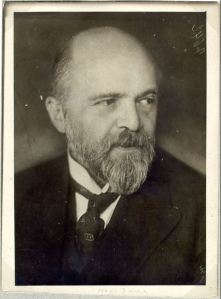 Hans Driesch, embryologist
Hans Driesch, embryologist
and champion of neo-vitalism.
One historical example is the neo-vitalism controversy arising from scientific concerns in late 19th and early 20th century embryology. The problem of giving satisfactory mechanical explanations of central features of organic life, such as heredity and embryonic development, was the source of this dispute, which concerned not only the philosophical “superstructure” of the life sciences, but practical methodological issues as well. In the 1890s, the German embryologist Hans Driesch’s experiments with sea urchin eggs seemed to suggest that each individual cell after the first cleavage could potentially develop into a whole organism. This contradicted the best mechanistic theory available at the time, namely August Weismann and Wilhelm Roux’ theory that all the hereditary material was present in the fertilized egg and then distributed through cell division. After trying in vain to make his findings square with a mechanistic conception, Driesch proposed a radically different theory. In his 1899 monograph Die Lokalisation morphogenetischer Vorgänge; ein Beweis Vitalistischen Geschehens Driesch proposed that organisms were “harmonious equipotential systems”. The neo-vitalistic concept of entelechy was born: a non-material directing principle that already contained the plan of the whole organism within it, directing the production of biological forms by way of a mysterious non-material, teleological agency .
It was a concept not unlike Sheldrake’s own “morphic resonance”. While Die Lokalisation morphogenetischer Vorgänge was a rather less sexy title than Sheldrake’s A New Science of Life, the biographical similarities of the authors are rather similar as well. Both were young biologists with impressive early achievements, whose first major publication would be on a vitalistic theory at odds with most of their peers.
Both Sheldrake and Driesch are good examples of what I call "discovery enthusiasm".
Another similarity concerns the two scientists’ attitude to criticism. Driesch frankly did not spend much time listening to his critics—even when better mechanistic theories were developed in his field, solving the problems he had been struggling with and achieving great successes, he continued talking about entelechy. While embryologists were busy discovering the role of chromosomes in heredity and laying the groundwork of the modern synthesis of Mendelism, Darwinism, and population statistics, Driesch in fact expanded the principle of entelechy, to deal with contexts quite different from the original embryological one. Again, not unlike Sheldrake, Driesch took his biological concept to bear on subjects such as parapsychology, the soul, and the philosophy of life. Both Sheldrake and Driesch are good examples of what I call “discovery enthusiasm”: scientists who think they have made a revolutionary break-through, follow up by expanding the application of their discovery to increasingly more lofty fields, and typically meet resistance and counter-theories by increasing their zeal and looking for support in popular, philosophical, or religious communities rather than in their original scientific community.
While the vitalistic controversy started by Driesch was, from a scientific point of view, settled within few years, the door to vitalism and other non-mechanistic theories of life remained temporarily open in the scientific discourse of the early 1900s. On the more philosophical and speculative side, we have the crazed popularity of Henri Bergson’s vitalistic philosophy, the creation of various philosophies of emergence (notably by philosopher Samuel Alexander, the biologist/psychologist C. Lloyd Morgan, and philosopher C. D. Broad), and the “process philosophy” of Alfred North Whitehead. In addition to these, a significant number of celebrated biologists adopted broadly “organicist” rather than “mechanistic” research methods in the period between 1900 and 1940. Hans Spemann was even awarded a Nobel prize of physiology in 1934 for his work in the 1920s (with the PhD student Hilde Proescholdt—a poor victim of the “Matthew effect”, but that’s another story) on his essentially organicist concept of “the organizer”. When the scales tipped again, it was not so much a result of a repressive scientific establishment forcing its way, as the heavy weight of successful mechanistic explanations across a wide spectrum of biological and biochemical research that had been technically impossible in the 1920s.
 The philosophy of biology was
The philosophy of biology was
influenced by a commodified communist.
Finally, we should note that being an organicist and hence limiting the scope of “mechanism”, does not necessarily mean a hostility towards metaphysical views such as “materialism” or physicalism. This can be illustrated by other famous biologists with organicist leanings in the early 20th century, such as Joseph Needham. Needham was drawn to non-mechanistic theories of life from Friedrich Engels’ decidedly materialist philosophy of science. In fact, one way to distinguish “vitalism” from “organicism” is that vitalists are committed to non-materialism, while organicists can easily remain materialists. Under this definition, Sheldrake in fact appears more like a full-blown vitalist than an organicist.
This becomes clear in that he considers the second dogma of science to be:
2. "Matter is unconscious."
I will not spend too much time on this particular “dogma”, but rather treat it in continuation with the above. “Consciousness” is a common preoccupation of vitalists, who typically connect the conscious to the mysterious life force, and need both of which to be somehow irreducible and essential forces in the world. This means a break away from materialism and physicalism: whatever consciousness is, it is something other than a mechanical effect of material substances. Thus one might be drawn to various “animistic” theories, where” souls”, “spirits”, or other forms of conscious agents, are separable from material bodies and only inhabit them. That would be a rather common (and some would say intuitive) form of dualism. Alternatively one might want to save a monistic worldview, and hence avoid problems with mind/body dualism by postulating a form of panpsychism. Perhaps everything is inherently conscious, inherently “alive”?
There have been many proponents of various versions of this view throughout the history of western philosophy, but Sheldrake is probably quite right in stating that it is never considered seriously by science today. To cite his description of the “second dogma”:
“All matter is unconscious. It has no inner life or subjectivity or point of view. Even human consciousness is an illusion produced by the material activities of the brain.”
Quite right. But calling the lack of interest in various panpsychist theories “dogmatic” is to miss the point entirely. As with the prevalence of mechanism in scientific theorising, there are reasons why panpsychism is not very attractive. It starts with the status of “consciousness” itself, and with the strictures of scientific methodologies. How can one define consciousness in ways that make it possible to distinguish the conscious from the non-conscious? What are the observable traits of consciousness, how do we measure them? More radically, what does a concept of consciousness add to scientific explanation, and in what fields?
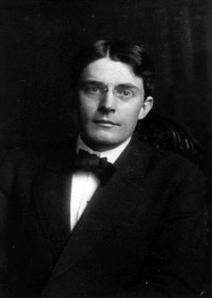 John Broadus Watson,
John Broadus Watson,
founder of behaviourism (sort of).
These are extremely tough questions, and it simply will not do to castigate science for not considering that “matter” might be “conscious”. (What is that even supposed to mean?) Even within the science that deals most closely with the field from which we happen to know about such a thing as “consciousness” (or think we do, anyway—let’s not be dogmatic about this!)—psychology—the concept has always been notoriously vague, imprecise, and void of explanatory power. When psychology was getting properly professionalised around the beginning of the 20th century, the concept was about to be ditched completely. Not only by the behaviourists—the movement pioneered by John B. Watson in 1913—but by functionalists as well. Anyone who has bothered to read Watson’s paper, “Psychology as the Behaviorist Views It” (which I believe has gotten an unnecessary bad reputation following Noam Chomsky’s dismissal of Skinner’s behaviourism and the foundation of cognitive science), will have found that the main objection there is not to a metaphysical theory, but to problems of precision in terminology, methods of measurement, experimental conduct, and theory building. Getting away from a focus on introspective analysis of the “contents of one’s mind” or “the structure of consciousness”, was necessary in order to build a psychological science that could say anything meaningful at all about the workings of minds.
Since then, of course, psychology has gotten much more sophisticated. Cognitive science has put mental content and internal processes on the map again, enhanced by an advancing neuroscience. But the point still remains: if determining conscious activity in animal and even human subjects has proved so incredibly difficult, how much sense does it make for a scientist to ask whether or not a grain of sand is “conscious”? What would be the criteria by which one could determine such a question? And more importantly, what would be the sufficient criteria to conclude that the speck is, indeed, unconscious?
A science that would treat random objects as conscious without considering questions such as these would be a truly dogmatic science. But the epistemological problem runs even deeper: To insist on keeping the question open even when there are scientific criteria around (in this case those of psychology and the philosophy of mind) that, if they were employed, would yield pretty clear answers, amounts to a form of special pleading. Or else a serious case of the (incredibly common) fallacy known as equivocation: if a pebble on the beach is conscious, it is not conscious in the same sense, or by the same definitions, as we intend when talking about human subjects as being conscious. The science of consciousness has descended into a game of words.
So much for mechanism, vitalism, panpsychism and consciousness. Next up we look at questions such as: Are the laws of nature fixed? Does nature have a purpose? And more importantly: is science dogmatic about these issues?
3. Muddled Conservations
In the previous post on Sheldrake’s Science Delusion I discussed the first two dogmas, concerning the “mechanical philosophy” and its challenges, and the question of whether matter is conscious. As we saw there, Sheldrake comes out as a sort of modern-day vitalist (even though he claims to be an organicist. I think his anti-materialism is actually more radical, placing him in the vitalist camp), and a mild supporter of panpsychism. In the present installment we shall look at the third dogma, where Sheldrake takes on a central conception of physics: that the matter and energy of the universe is constant, and subjected to laws of conservation and conversion.
3. “The matter and energy of the universe is constant”
With his discussion of this third dogma, Sheldrake’s real objective is to question the status of the conservation laws. That is certainly no mean task. The chapter dedicated to this dogma is a strange read, as perhaps one would expect. Judging from the span of its content it could have been entitled something like “what has dark matter got to do with anorexia”, but the reader would still remain hard pressed for an answer when completing the chapter.
 Concreteness misplaced in a can.
Concreteness misplaced in a can.
Sheldrake makes a big point out of claiming that the discovery of dark matter and dark energy challenges the laws of thermodynamics. As in much of his argumentation, there is a grain of truth in this: theoretical physics has been working hard to find out precisely what the relations between “dark” and ordinary energy/matter really is, and how the conservation and conversion laws apply. But, of course, that is not because one has clearly identified a wonderful, weird tangible substance—“dark matter”—which is in every way material but upsets the laws of conservation. Dark matter and energy are hypothetical entities that might account for strange gravitational effects observed in deep space. One knows little about any physical entities out there, but choose terminology for the hypothesis that relate to things one does know something about. As is so often the case with mystery-mongering about physics, however, scientific nomenclature is treated with misplaced concreteness. Abstract terms are treated as physical objects, metaphorical descriptions as real features. (This is probably one of the most common fallacies in popular science and sadly it is to some extent encouraged by scientists in their attempt to make theories accessible.)
But even if we were feeling generous, and granted that the conservation of energy is actually contradicted by dark energy as it mysteriously propels the expansion of the universe, that would still not mean that the law’s applicability to ordinary matter and energy had come into question. Hence Sheldrake is going quite a bit too fast when he progresses from a discussion of the strangeness of dark energy to make the case that conservation must be abolished in accounting for human metabolism. This is another type of slippage common among mystery-mongers (just think of the countless misapplications of quantum-mechanical concepts to macro-physics).
It is dubious that dark energy makes the phenomenon of “inedia” much more credible—people who claim not to eat or drink for years, yet still apparently keep on living without too much difficulty (such as the ever-lovely “breatharians“). So what are we to make of the “unexplainable” cases Sheldrake mentions explicitly? As an historian of religion I find that Sheldrake’s accounts of some of these are strikingly naive—despite his attempt to come across as a sceptic. Consider his reminiscence of meeting a “holy woman” in Rajasthan, who was said by other locals to not have eaten in 43 years, and not producing any feces or urine:
“Of course I assumed that she must have been eating and drinking secretly. Yet her devotees were adamant that she was genuine. Some had known her for years, even lived with her, so had had the opportunity to see if she was eating behind the scenes. Either they were part of a conspiracy, or she was a very skilled deceiver. My skepticism was an immediate mental reflex. But when I met her, and talked to people who knew her, she did not strike me as a charlatan, but as a woman of sincere religious faith.” (p. 78; emphasis added).
 Prahlad Jani, a famous Indian breatharian,
Prahlad Jani, a famous Indian breatharian,
here being inspected by a medical team.
There has been a long controversy in India
over the sadhu's professed ability to live
without food and water for 70 years.
Clearly scepticism does not run very deep when one is ready to throw out overwhelmingly well-tested knowledge about thermodynamics because the “anomaly” happens to be a nice person, surrounded by nice trusting friends. But what I find most revealing with this quotation is the final sentence. There is no reason to think that there is a clear-cut difference between “charlatanry” and “sincere religious faith”. Trickery, illusion, and sleight-of-hand have always been important tools of priestcraft, although in varying degree through historical periods and cultures. Holy trickery is not necessarily an insincere act of deception either, and surely not something that precludes really believing. Sheldrake happens to be shaped by a predominantly Protestant culture that has succeeded in instating the distinction between “genuine faith” and fake tricks. He also happens to be a scientist and a realist, so he assumes that someone who appears religiously devout is not cheating but actually producing “real” phenomena that can tell us something about the way the world works.
So how does he explain them? This is rather interesting: The careful reader will notice that when Sheldrake theorizes around phenomena such as inedia, he invariably reverts to argumentation that bases itself on—yes, you guessed it—the conservation of energy. Thus, the mysterious discrepancy between input and output of energy in a biological system, such as when a yogi claims not to have eaten in 40 years, is explained either by the organism’s ability to absorb energy directly from the sun, or through making use of other forms of energy as of yet unknown to mainstream science—such as “prana”. Well, if that‘s the case, then one is still dogmatically trying to make the strange case fit with the conservation of energy. The reasoning is that something is missing—hence one goes looking for it in other sources, such as the sun, the air, or the astral plane. A new source of energy accounting for that which mysteriously appears out of nowhere means playing by the same dogma Sheldrake claims to criticise. It permits a whole new set of “prana—kinetic energy” conversion laws. If one really wanted to ditch conservation, it would be better to say that the discrepancy of input and output is actual, attribute it to a miracle, and leave it at that. But it’s not a particularly scientific attitude, and it’s not the attitude Sheldrake seeks.
4. On natural laws and resonating habits
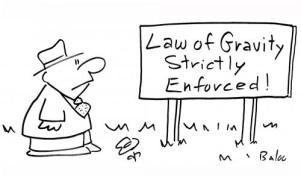 Laws as a bad metaphor:
Laws as a bad metaphor:
Who’s enforcing what on whom?
It has been a while since my last post on Rupert Sheldrake’s Science Delusion, or, as it is called in the United States version (published by none other than Deepak Chopra Books—no doubt a token of proper peer-reviewed science), Science Set Free. For new readers as well as for old ones who need to refresh their memories, previous installations in the series are found here, here, and here. Without further ado, let me get started on an evaluation of the fourth dogma ascribed to science: “The laws of nature are fixed”. As in previous posts, evaluating this dogma (and whether it is one to begin with) will occasion a few short excursions in the philosophy and history of science. But this time we are also led, finally, to confront Sheldrake’s own key thesis, namely his theory of “morphic resonance”. Read on if you’re still curious.
4: “The laws of nature are fixed”
Sheldrake’s claim here is not very controversial when we look below the surface rhetorical level.
Are the laws of nature fixed once and for all? The dogmatic answer of science is “Yes”, according to Rupert Sheldrake’s fourth dogma. Curiously, though, the chapter dedicated to arguing this point suggests that this is actually not the case: To the contrary, Sheldrake demonstrates (perhaps despite himself) that there is today a lively and ongoing science-internal discussion about the nature and stability of such things as the physical constants, and the reach and universality of the laws of nature. In fact, Sheldrake’s beef here is not with science, but with what he identifies as “Platonism”: the philosophical view that these “laws” are independent of the things they “govern”. This “platonic” view may have just as much to do with the metaphor of governance itself: the laws of a society are distinct from the subjects of that society, and so the application of universal laws to natural particulars already suggests an ontological difference.
The position Sheldrake supports stands in a different tradition. He holds that the regularities of nature are more akin to evolving habits than to universal laws. Laws do not define and constrain the behaviours of natural entities, processes, and interactions, but describe their habits. By way of a version of the problem of induction, he can hold that the universality of these habits, as described and worked out mathematically, does not follow from the observation.
 Library of Babel as visualized
Library of Babel as visualized
by Erik Desmazieres.
This argument, of course, could be used to support a radical form of scepticism about what kind of world we find ourselves in. It is logically possible that, by some random coincidence, we happen to be in a universe that has all the features of a structured and rational whole for a certain period of time, only to dissolve into a completely unrecognizable chaotic mess at some given point in the future. The situation would be similar to that faced by someone entering Jorge Luis Borges’ “Library of Babel”, which contains all possible books of all possible combinations of letters and punctuation marks. By far the most of these books are complete gibberish from start to finish; a very small amount of them will be written with proper syntax—and a subset of these will be real classics, written in masterful prose. But there will also be a much greater set of books that look masterful until you reach page 231, where they suddenly collapse into meaningless strings of letters and punctuation marks. Our world could, conceivably, be just like this. The laws of nature might be nothing but the faux syntax of such a randomly generated text.
Now, this is not what Sheldrake is arguing when challenging the universality of laws. He argues that regularities are habits that have evolved through the history of the world. In a sense this strengthens the temporal and even historical aspect of the world (“natural history” becomes once more an apt term for science). As was the case with his position on minds, mechanisms and organisms (discussed here), this does not make him a completely novel thinker but rather places him in an alternative tradition that has deep roots in Western natural philosophy. We could list, for example, the medieval distinction between natura naturata (“nature natured”) and natura naturans (“nature naturing”), made famous through Spinoza’s natural philosophy, and its reception in e.g. German romantic Naturphilosophie around the turn of the 19th century. This type of speculation emphasises nature’s creative potential, its self-causing, generative properties, that give rise to stable phenomena without the incursion of non- or super-natural agents or forces (whether a theistic god, an indifferent and distant “first mover”, or Platonic/Pythagorean disembodied numbers). This stream of thinking obviously has affinities with vitalistic and organicist theories, and in more recent times we find varieties of it in Driesch’s “entelechy”, Bergson’s “élan vital” and “creative evolution”, and to some extent in modern emergentist philosophies of nature. (I’ve written about some of these in a different context here).
It could be added that one wouldn’t even have to go to such exotic systems to find a case against the rather naive jurisprudence metaphor of natural laws. Mainstream philosophy of science has plenty of sophisticated alternatives to offer, most often basing itself on forms of dispositional essentialism, which imply that “laws of nature” are metaphysically contingent on particulars and their arrangement, rather than the other way around.
In other words, Sheldrake’s claim here is not very controversial when we look below the surface rhetorical level. Certain dispositions can only be realized under conditions that only obtain relatively late in the history of the universe, for example, and some dispositions may even be seen as emergent properties showing up when new objects come into existence. (This, however, still allows for a sort of ceteris paribus understanding of natural laws, but that is perhaps a different discussion that takes us too far afield).
As usual, things get a lot more controversial when Sheldrake starts explaining his own alternative (ignoring all the other options while he is at it). It is in the chapter on natural laws (why exactly it is introduced at this point is not too clear) that the real motivations for writing this book become apparent: it is not that “science” is so dogmatic and closed and settled—Sheldrake ironically demonstrates that this is false by quoting from mainstream science to show how diverse the range of theorising is—it is rather that his own particular “theory of everything”, the theory of “morphic resonance” and “morphic fields”, happens not to have been taken seriously by the wider research community. Starting on page 99 of his book, morphic resonance is introduced and explained at some length as a framework for a habitual understanding of laws. But it goes much further than that, indeed, much further than what seems necessary for an alternative account of the lawlike behaviour of natural phenomena. Morphic resonance, in Sheldrake’s view, implies that all self-organizing systems (from molecules to organisms to planetary systems) are held together by “organizing fields”, “within and around the system it organizes, and is a vibratory pattern of activity that interacts with electromangetic and quantum fields of the system” (p. 100). But the truly mysterious property of these “morphic fields” is that they work by a form of non-local (but time-dependent) imitation. They are, to quote Sheldrake once more,
“shaped by a morphic resonance from all similar past systems, and thus contain a cumulative collective memory. Morphic resonance depends on similarity, and is not attenuated by distance in space or time.” (p. 100)
The latter cannot be entirely true, for it is crucial to Sheldrake’s further argument that imitation only works backwards in time, not forwards—it follows a time arrow, and is not reversible. What are the implications of this? It means that whenever something has happened, its likelihood of happening again increases. The first time a certain molecule is shaped, it is likely to suddenly be shaped again elsewhere in the universe. When a certain organism develops a certain organ, morphic resonance will transfer the pattern elsewhere, get picked up by a morphic field somewhere in the universe, and voila, the feature emerges again.
Morphic resonance thus becomes a general theory of habits, memory, imitation, and form-production that is designed to counter “materialistic” accounts of such phenomena. But what does it add? What are the unsolved scientific problems that this theory actually can explain? How well does it explain them? And crucially (a point almost universally lost on all “discovery enthusiasts”, and a good alternative candidate for defining “pseudoscience”): At what costs in terms of our already well-established, well-tested knowledge of how the world works?
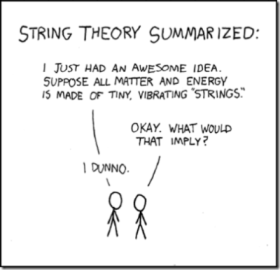
Giving Sheldrake some credit, his theory is able to some extent to generate novel predictions. Most notably, morphic resonance would predict that imitations of form can happen without any physical contact, so that, if one has a genuinely new form of organisation, and is able to keep it under absolute control, the theory would predict that it is still possible for the form to be reproduced elsewhere, by mysterious action at a distance from one morphic field to another. However, these are predictions of an extremely vague sort, that will always come with plenty of escape routes in the face of apparently disconfirming evidence: the theory does not specify any limitations in terms of distance, or even time (except that retrocausality appears to be ruled out), nor any direction in which the resonance will be emitted, making it impossible to predict where, when, and how the form is supposed to be replicated. In other words, a critic might argue that the production of a certain new synthetic compound, kept isolated in a laboratory, should have sent resonance waves that would cause the compound to suddenly start manifesting naturally. Sheldrake, however, could easily dodge the bullet and say that absence of evidence is not evidence of absence: perhaps the compound is just a bit too novel, requiring special circumstances to manifest; and perhaps the compound in fact has started to appear spontaneously on some far away planet? With the number of likely planets in the universe estimated to be in the sextillions (i.e. > 1x1026) it is still possible that the effect could be huge on a cosmic scale without us knowing it from our position on earth.
Sheldrake does in fact use an argument like this. His favourite example is crystallization, or more precisely one puzzling phenomenon associated with “polymorphism”. Some chemical compounds have the ability to crystallize in different forms; the different shapes are called “polymorphs” of the given compound. The “mystery” that Sheldrake adopts as an interesting “anomaly” to be explained by a new theoretical construct (his theory of morphic resonance) is that apparently, once some compound have crystallized in a specific way, chemists find it very difficult to get it to crystallize in any other way. It is as if the compound as a whole (and not just locally, in a given laboratory) had “learnt” one specific way, and found it very hard to unlearn this habit. Morphic resonance, working non-locally?
Maybe not. The problem is well-known, and is generally considered a technical problem that has to do with contamination. Tiny crystals may leak from laboratory conditions, and when they come in contact with other compounds will spread the form by way of a sort of “contagion”. This is a well-known and well-documented effect, and there has even been court-cases revolving around the problem in the pharmaceutical industry, where such crystal contagion has real effects both in terms of patent rights, and in terms of the actual medical effect of certain drugs. One slightly apocryphal story goes that new crystals travel from laboratory to laboratory by getting stuck in the beards of scruffy research assistants, contaminating samples as soon as they are being checked.
In any case, there is no anomaly left to explain: one has a perfectly sound mechanism within present models, and a theory of morphic resonance would not add anything of interest (except of a pretty superfluous metaphysics). The new predictions it may offer remain far outside of anything that is of practical significance until we become an intergalactic species. This is apparently good enough for Sheldrake, who writes the following at the end of his chapter, apparently finding it a convincing and promising line of inquiry:
“[I]t should be possible to discover which new chemicals are unique to earth and which have existed elsewhere. If the rate of crystallization of, say, a thousand new chemicals is measured systematically, and if, say eight hundred show increasing rates of crystallization while the other two hundred do not, we could infer that the latter have existed elsewhere in the universe, but the former have not. Inexpensively, we could find what is truly new on earth, and deduce something about events on other planets, even though we do not know where those planets are.” (p. 108)
Inexpensive, perhaps, in terms of research costs, but hardly parsimonious as a hypothesis. And hardly a good substitute for generating evidence that can actually be checked, unless science is to fall into a real dogmatic slumber.
To Be Continued
|
 Egil Asprem is a Norwegian scholar of esotericism, religion, and intellectual history, with a penchant for philosophy (mostly analytic). He is currently a postdoctoral scholar in the Department of Religious Studies at University of California Santa Barbara and the author of Arguing with Angels (SUNY Press, 2012), Contemporary Esotericism (Equinox / Acumen, 2013) and the award winning dissertation The Problem of Disenchantment (PhD thesis, University of Amsterdam, 2013). Check out his blog.
Egil Asprem is a Norwegian scholar of esotericism, religion, and intellectual history, with a penchant for philosophy (mostly analytic). He is currently a postdoctoral scholar in the Department of Religious Studies at University of California Santa Barbara and the author of Arguing with Angels (SUNY Press, 2012), Contemporary Esotericism (Equinox / Acumen, 2013) and the award winning dissertation The Problem of Disenchantment (PhD thesis, University of Amsterdam, 2013). Check out his blog.










